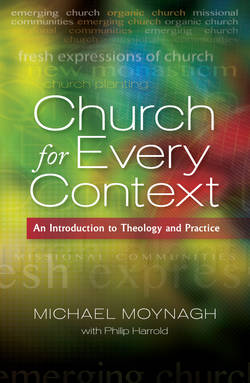Читать книгу Church for Every Context - Michael Moynagh - Страница 48
На сайте Литреса книга снята с продажи.
Contextual Churches in History
Оглавлениеphilip harrold
The incarnation reminds us that history is essential to Christianity. When the Word became flesh and dwelt among us, history turned in a new direction. In this chapter, we will see how down the centuries the church has translated that divine action into a dazzling array of cultural contexts. As a missionary community the church remembers God’s call to be a pilgrim people rooted in the gospel of Jesus Christ. The church is on the move – ‘hastening to the ends of the earth to beseech all men to be reconciled to God . . .’ (Newbigin, 1953, p. 25).
The history of this movement has defined the church as we know it today, but nonetheless it remains a strange story. Neither the continuities nor the discontinuities should surprise us given what we have already observed about contextual churches in the New Testament. It was there that novelty and innovation mixed with traditional ways of doing things in a process that propelled the church for centuries to come. The unevenness of historical records does not allow us to recognize every aspect of the subsequent church expansion, but looking for missional, contextual, formational and ecclesial features makes the past come alive, as we shall see.
History may not be very good at telling us what to do, but it can stimulate thinking about new possibilities. It is tempting to read the past in order to justify the present or to mould the past into our own perspectives. To avoid this, the chapter will stress both familiarity and strangeness in the long history of new contextual communities. Given that the church is missionary at its heart, it is possible for modern Christians to see a family resemblance in the historic body of Christ, even as it sometimes confounds our expectations. We may then recognize ‘a whole immeasurable exchange of gifts, known and unknown’ by which we carry on the mission to which we have been called’ (Williams, 2005, pp. 25–7).
Recall from the last chapter that in the Book of Acts the mission to Antioch presented the early church with an unprecedented opportunity. The general contours of a new Christian community emerged as the apostles began to acquaint large numbers of non-Jewish people with the gospel. Meanwhile, the Jerusalem church provided leadership drawn from its rich heritage and venerable location. Together, the Jerusalem and Antioch communities comprised a ‘mixed economy’, existing and new churches in relationship with each other, with Antioch taking the lead in establishing a new mission frontier. The community of believers in Antioch, emerging among the Gentiles, was necessarily contextual and, as a result, the first church founders learned how to do things differently.
This is where our history of new Christian communities will begin. Naturally, we would like to know more about the first mission outpost of the church. How did it reach out? How did it settle into its new surroundings? How did it form people in the image of Christ and make disciples? And how did it imagine itself to be the body of Christ despite its emergent status?
